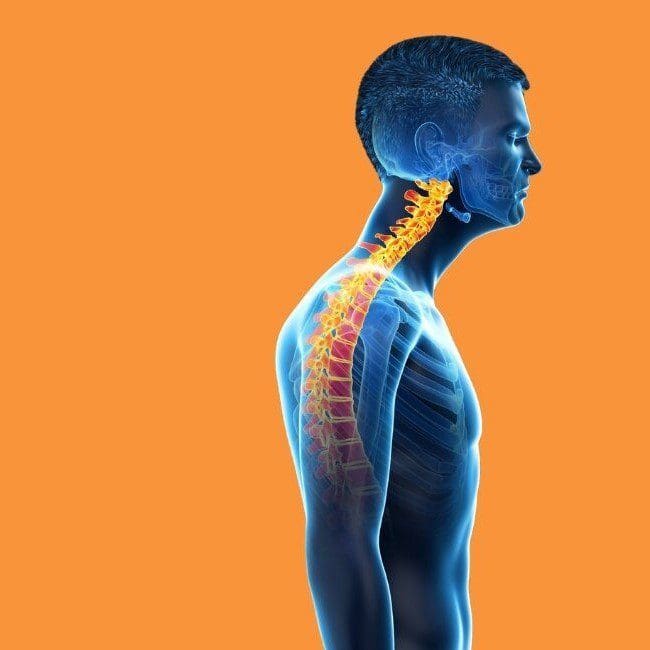
How to fix your forward head posture
Overview
Forward head posture (FHP) is a common condition where your head is positioned with your ears in front of your body’s vertical midline. In normal or neutral head posture, your ears line up with your shoulders and midline. FHP can cause neck pain, stiffness, an unbalanced gait, and other side effects. It’s also often associated with rounded shoulders, called kyphosis. FHP is also called “text neck” or “nerd neck,” because it results from prolonged bending toward a computer screen or hunching over a laptop or cell phone. It’s also associated with the loss of muscle strength in the aging process.
The good news is that you can usually fix it: Stretching and strengthening exercises along with paying attention to good posture relieves side effects and restores better posture.
Anatomy
Forward head posture (FHP) is a poor habitual neck posture. It often co-exists with Upper Crossed Syndrome defined by hyperextension of the upper cervical vertebrae and forward translation of the cervical vertebrae.
Thoracic Kyphosis is a complication of the combination of slouched-forward shoulders and rounded upper back. This can lead to a painful shortening of the muscles of the back of the neck, as well as compression of the cervical vertebrae—the uppermost portion of the spine that supports the head and protects the spinal cord.

Symptoms
Due to the increased compressive forces through the neck joints and increased muscle tension, pain is the common outcome. Some of the types of problems associated with FHP are:
- Headaches
- Neck discomfort
- Muscle tension in the neck and shoulders
- Discomfort in the mid back
- Chest pain
- Pain, pins & needles and numbness in the arms and hands
Causes
People may associate FHP with using electronic devices for a long time, such as cell phones or computers.
However, any activity that causes a person to lean their head forward for a prolonged period of time can lead to chronic FHP.
- slouching
- sleeping with the head raised
- carrying a heavy backpack or purse
- driving with a hunched back
- sewing
- reading in bed
- whiplash or other injuries to the spine
- weakness in the muscles of the upper back
- arthritis and bone degeneration
Diagnosis
Forward Head Posture (FHP) is a common postural imbalance that occurs when the head moves forward from its normal alignment with the spine. It can cause a range of problems, including neck and shoulder pain, headaches, and even reduced lung function. Diagnosing FHP involves a combination of physical examination and observation of the patient’s posture.
Here are the steps that may be taken to diagnose FHP:
- Patient history: The healthcare professional will ask the patient about their symptoms and any history of neck or shoulder pain. They may also ask about their occupation, lifestyle, and any recent injuries or surgeries.
- Physical examination: The healthcare professional will assess the patient’s posture, looking for any signs of FHP. They may ask the patient to stand upright against a wall, and then observe the alignment of the head, neck, and spine. They may also examine the patient’s range of motion, muscle strength, and any tenderness or pain.
- Imaging tests: In some cases, imaging tests may be ordered to get a more detailed look at the patient’s neck and spine. This can include X-rays, MRI scans, or CT scans.
- Assessment of muscle imbalance: FHP is often caused by muscle imbalances in the neck and upper back. The healthcare professional may assess the patient’s muscle strength and flexibility, looking for any areas of weakness or tightness.
- Other potential causes: It’s important to rule out other potential causes of neck and shoulder pain, such as spinal conditions or nerve impingements.
Overall, diagnosing FHP involves a thorough examination of the patient’s posture, range of motion, muscle strength and flexibility, and any potential underlying conditions. Once a diagnosis is made, treatment can involve a combination of exercises, manual therapy, and lifestyle modifications to correct the posture and address any underlying issues.
Treatment
The treatment of Forward Head Posture (FHP) typically involves a combination of exercises, manual therapy, and lifestyle modifications to address the underlying causes of the condition. Here are some general steps that may be taken to treat FHP:
- Corrective exercises: Exercises that strengthen the neck and upper back muscles can help to improve posture and reduce the strain on the neck and shoulder muscles. These may include chin tucks, shoulder blade squeezes, and neck stretches.
- Manual therapy: This may involve hands-on techniques such as massage or chiropractic adjustments to help correct spinal alignment and improve range of motion in the neck and upper back.
- Postural changes: Making changes to your work environment or daily habits can help to reduce the strain on your neck and upper back muscles. This may include adjusting your computer monitor height, using a supportive chair, or taking breaks to stretch and move throughout the day.
- Lifestyle modifications: Factors such as stress, lack of sleep, and poor diet can contribute to muscle tension and postural imbalances. Taking steps to manage stress, improve sleep quality, and eat a balanced diet can support overall physical and mental health and reduce the risk of FHP.
- Bracing: In severe cases of FHP, a brace or collar may be recommended to help support the neck and reduce strain on the muscles. However, this is typically a short-term solution and should be used under the guidance of a healthcare professional.
It’s important to work with a healthcare professional who can provide a personalized treatment plan based on your individual needs and underlying causes of FHP. With the right approach, it is possible to correct FHP and improve overall posture and health.
Exercises
Here are some exercises that can help to strengthen the neck and upper back muscles and improve posture in individuals with Forward Head Posture (FHP):
Chin tucks: Sit or stand with your back straight and your shoulders relaxed. Keeping your eyes facing forward, gently tuck your chin in towards your chest, as if making a double chin. Hold for 5-10 seconds and then release. Repeat 10-15 times.
Shoulder blade squeezes: Sit or stand with your back straight and your shoulders relaxed. Squeeze your shoulder blades together, as if trying to hold a pencil between them. Hold for 5-10 seconds and then release. Repeat 10-15 times.
Wall angels: Stand with your back against a wall, with your feet about 6 inches away from the wall. Raise your arms up to a 90-degree angle, with your elbows and wrists touching the wall. Slowly slide your arms up and down the wall, maintaining contact with your elbows, wrists, and fingers at all times. Repeat 10-15 times.
Neck stretches: Sit or stand with your back straight and your shoulders relaxed. Gently tilt your head to one side, bringing your ear towards your shoulder. Hold for 10-15 seconds and then release. Repeat on the other side. Repeat 3-5 times on each side.
Upper back stretch: Sit or stand with your back straight and your shoulders relaxed. Clasp your hands in front of you and round your upper back, bringing your chin towards your chest. Hold for 10-15 seconds and then release. Repeat 3-5 times.
Remember to start with a few repetitions of each exercise and gradually increase the number of repetitions and the level of difficulty as your muscles become stronger. It’s also important to maintain good posture throughout the day and take frequent breaks to stretch and move.
Prevention
Forward Head Posture (FHP), also known as “text neck,” is a common condition that affects people of all ages. It occurs when the head is positioned forward in relation to the shoulders, which places strain on the neck and upper back muscles. Over time, FHP can lead to chronic pain, headaches, and even spinal damage. However, there are several steps that you can take to prevent FHP.
- Be mindful of your posture: The first step to preventing FHP is to be mindful of your posture. Avoid slouching or leaning forward when sitting or standing. Instead, sit up straight with your shoulders back and your head aligned with your spine.
- Adjust your workspace: If you spend a lot of time sitting at a desk, it’s important to make sure that your workspace is set up correctly. Your computer screen should be at eye level, and your keyboard and mouse should be positioned so that your arms are at a comfortable angle. Use a supportive chair with good back support to prevent slouching.
- Take regular breaks: It’s important to take regular breaks when working or using electronic devices. Every 30 minutes, take a few minutes to stretch and move around. This will help prevent muscle tension and fatigue, which can lead to FHP.
- Strengthen your neck and back muscles: Strengthening your neck and upper back muscles can help prevent FHP. Incorporate exercises such as neck retractions, chin tucks, and shoulder blade squeezes into your daily routine. These exercises will help strengthen the muscles that support your head and neck.
- Stretch regularly: Stretching regularly can also help prevent FHP. Incorporate neck stretches and upper back stretches into your daily routine. These stretches will help increase your range of motion and prevent muscle tension.
In conclusion, FHP is a common condition that can lead to chronic pain and spinal damage. However, by being mindful of your posture, adjusting your workspace, taking regular breaks, strengthening your neck and back muscles, and stretching regularly, you can prevent FHP and maintain good spinal health. If you are experiencing pain or discomfort due to FHP, it’s important to seek medical attention to prevent further damage.



